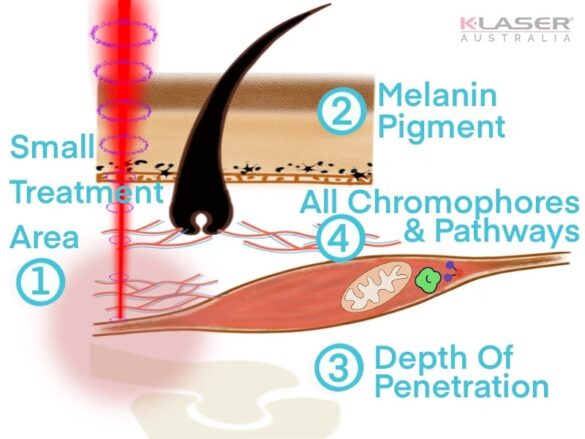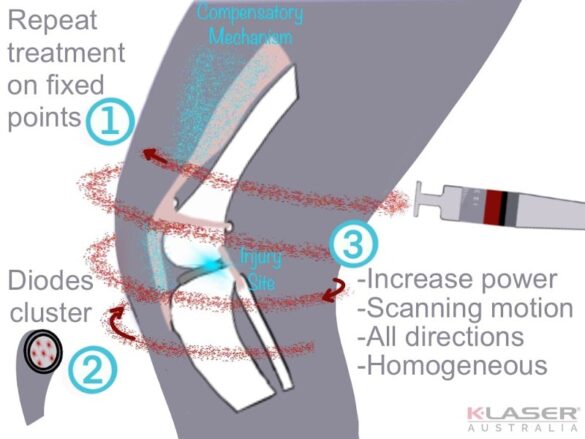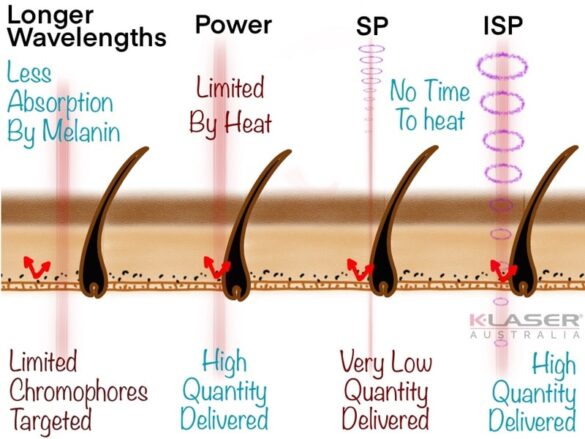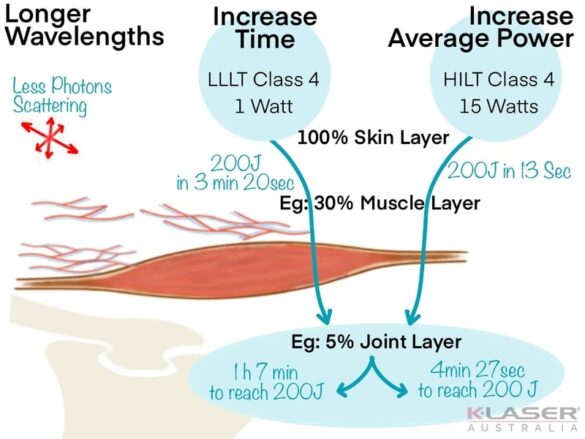OVERCOME THE LIMITATIONS OF LASER THERAPY
During STEP-1, it was demonstrated that laser therapy has opened the door to many exciting fields of applications. However, inconsistent results in practice have highlighted the clinical limitations of laser therapy treatments over the years. These limitations are often due to physical constraints that prevent the correct dosage and wavelengths from reaching the targeted tissues.
K-Laser has been able to overcome these limitations for health professionals by applying advanced proprietary technological features.
1 - Small Treatment Area
Limitation #1 | Small Treatment Area |
Issue |
|
Option 1 | Increase treatment time: Repeat treatment on several fixed points |
Option 2 | Increase number of diodes (cluster of diodes) |
Option 3 | Increase average power of the diode and apply scanning motion |
K-Laser Technology | K-Laser offers an all-in-one homogeneous laser beam with high average power for scanning motion. |
Issue
Injuries can often involve large areas and lead to compensatory mechanisms in adjacent tissues. However, first generation low level laser therapy devices (such as Class II and Class IIIb devices) are typically designed to treat small areas at a fixed point, often less than 1 cm2.
As a result, these devices only partially target the injured site and treat in only one direction.
Option 1 - Increase treatment time
Repeatedly treating small areas of a larger injury site is one solution to treating a larger area, but this approach is not comprehensive, as it does not treat all affected tissues, and is highly time-consuming, taking up to 45-60 minutes.
Such prolonged treatments are inconvenient for health professionals, as they result in lower hourly rates and high costs for patients.
Option 2 - Increase number of diodes
Increasing the number of diodes on the handpiece can be a more effective solution than the first option. However, even with a cluster of diodes, the practitioner would still need to repeat the treatment to cover adjacent tissues and treat in all directions.
As a result, this approach is still time-consuming (taking 25-45 minutes) and doesn't provide homogeneous coverage since a cluster is a series of points.
Option 3 - Increase average power of the diode
By using a High Intensity Laser Therapy (HILT) Class IV device and expanding the spot size into a homogeneous laser beam, practitioners can take a different approach to treating injuries. This involves significantly increasing the average power of the laser device, which allows for the treatment of larger areas in a scanning motion in just 3-5 minutes.
This approach provides more efficient and effective treatment for patients while also allowing practitioners to see more patients in a shorter amount of time, ultimately increasing their hourly rate.
Technology Utilised by K-Laser
K-Laser utilizes a large spot size of 12-16 cm2 and a highly homogeneous beam. As HILT Class IV devices, all K-Lasers have high average power ranging from 12W-25W, enabling practitioners to treat the entire injury site and surrounding tissues simultaneously. Additionally, the scanning motion feature allows for treatment in all directions.
2 - Melanin Pigment
Issue
Melanin pigments in individuals with dark skin and hair can serve as a chromophore that absorbs photons, which can be advantageous when targeting superficial tissues like wounds and hematomas. However, melanin can also pose a significant challenge for the laser beam when trying to penetrate to reach deep tissues such as muscles, joints, tendons, and nerves.
Option 1 - Increase average power
Increasing the power of the laser beam to deliver more photons to deeper tissues behind the melanin barrier may seem like an intuitive solution, but it is limited by the potential for heat generation in the superficial tissues.
Option 2 - Use longer wavelengths
The coefficient of photon absorption by melanin is wavelength-dependent, with:
- Shorter wavelengths (below 800nm) being highly absorbed
- Medium wavelengths (800-900nm) moderately absorbed
- Longer wavelengths (above 950nm) having low absorption.
Longer wavelengths can penetrate deeper into tissues and have limited interaction with melanin. However, using only longer wavelengths (970nm, 1064nm) would only target specific chromophores such as CA Channel and water, but not others like Cytochrome c Oxidase and hemoglobin.
This limited targeting would result in restricted clinical outcomes.
Option 3 - Pulsing, SuperPulse, IntenseSuperPulse
Pulsed waves: (PW)
An alternative to using Continuous Wave (CW) is to generate Pulsed Waves (PW), which provides a cooling period during the T-OFF interval for the superficial tissue. However, this approach also reduces the amount of energy delivered to deeper tissues as pulsing creates a 50% duty cycle.
Super-Pulsed waves (SP)
Another option to consider is the use of SuperPulse waves.:
- With a very short Time-ON (in the nanosecond range), superficial tissues do not have enough time to heat up, resulting in high peak power.
- However, the Time-OFF is so long that the delivery of photons is extremely low (low average power).
IntenseSuperPulsed waves (ISP)
IntenseSuperPulse technology combines the benefits of both SuperPulse and high average power. It is similar to SuperPulse in terms of being safe for superficial tissues, but with the added advantage of delivering a high quantity of photons to deep tissue.
Technology Used By K-Laser: ISP
K-Laser technology combines all options to minimise melanin interception:
- SuperPulse and high average power to deliver a large quantity of photons to the deep tissues while minimizing heat generation in superficial tissues.
- 4 simultaneous wavelengths, including short, medium, and long wavelengths, to target all chromophores and increase penetration depth
- Pulsed waves and IntenseSuperPulse waves are activated when necessary
3 - Limited Depth Of Penetration
Issue
When photons penetrate tissues, they interact with matter through a process called scattering, which causes the energy to be dispersed in multiple directions. As a result, the amount of energy reaching deeper tissues decreases significantly. After a few centimeters of penetration, only a small proportion of the initial dose applied at the surface reaches muscles, joints, and tendons, ranging from 30% to as little as 1%.
Option 1 - Use longer wavelengths
While longer wavelengths are less scattered than shorter wavelengths and can penetrate deeper into tissues, using only long wavelengths would limit the PhotoBioModulation pathways that can be targeted.
Option 2 - Increase time of exposure
Increasing the time of exposure (20-60 minutes) is a solution with limited power laser devices, but it may not be convenient for healthcare practitioners with busy schedules. Additionally, recent studies have demonstrated that a higher speed of treatment delivery, as measured by power density at depth (W/cm2), has a positive impact on clinical outcomes.
Option 3 - Increase average power
Increasing the average power of laser devices can allow a higher quantity of photons to reach deep tissues faster, as the proportion of energy reaching deep tissues remains the same. However, this solution is only feasible with HILT Class 4 laser devices.
K-Laser Technology Used
K-Laser technology combines all options to safely adapt to any depth:
- High average power is available
- 4 simultaneous wavelengths (short, medium, and long) are present to target all chromophores.
4 - Inability to stimulate all chromophores & pathways
Limitation #4 | Inability to stimulate all chromophores & pathways |
Issue | Limited laser parameters |
Option 1 | Multiple wavelengths simultaneously |
Option 2 | Use specific pulsing frequencies and Continuous Wave |
Option 3 | Multi-phase treatment with several pulsing frequencies |
K-Laser Technology |
|
Issue
In STEP-1, we learned that PhotoBioModulation (PBM) involves multiple pathways, as evidenced by recent research.
Clinicians who utilize therapeutic lasers with inadequate technology may find it challenging to target specific pathways effectively.
Option 1 - Multiple wavelengths simultaneously
Each chromophore has an affinity for specific wavelengths, triggering complementary effects. Emitting multiple wavelengths simultaneously is the first solution to effectively target the respective chromophores.
Option 2 - Use specific pulsing frequencies and Continuous Wave
Numerous published studies have demonstrated that the clinical effects of therapeutic lasers can differ not only with dosage but also with pulsing frequencies or continuous wave mode. To address this, clinicians can benefit from having access to a broad range of pulsing frequencies and continuous wave options, allowing for a wider variety of treatment options.
Option 3 - Multi-phase treatment with several pulsing frequencies
A Multi-Phase laser device can optimize tissue response by delivering a succession of different pulsing frequencies and continuous wave modes during the same treatment.
K-Laser Technology Used
Every K-Laser device is specifically designed to activate all photobiomodulation chromophores and their pathways by offering various wavelengths, pulsing frequencies, and continuous wave options:
- 4 simultaneous laser wavelengths (970nm, 905nm, 800nm, 660nm)
- Continuous wave
- Pulsing frequencies from 1Hz to 20,000Hz.
- 1 to 12 configurable phases per treatment
Contact Us
Discuss Your Needs
Request Demonstration
Consider Your Options
Get A Price






